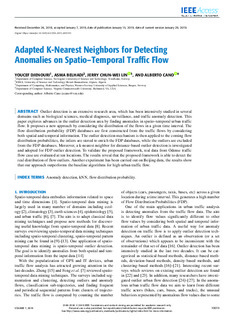Adapted k-Nearest Neighbors for Detecting Anomalies on Spatio-Temporal Traffic Flow
Journal article, Peer reviewed
Published version
Permanent lenke
http://hdl.handle.net/11250/2607547Utgivelsesdato
2019Metadata
Vis full innførselSamlinger
Originalversjon
Djenouri, Y., Belhadi, A., Lin, J. C.-W., & Cano, A. (2019). Adapted K-nearest neighbors for detecting anomalies on spatio–temporal traffic flow. IEEE Access, 7, 10015-10027. 10.1109/ACCESS.2019.2891933Sammendrag
Outlier detection is an extensive research area, which has been intensively studied in several domains such as biological sciences, medical diagnosis, surveillance, and traffic anomaly detection. This paper explores advances in the outlier detection area by finding anomalies in spatio-temporal urban traffic flow. It proposes a new approach by considering the distribution of the flows in a given time interval. The flow distribution probability (FDP) databases are first constructed from the traffic flows by considering both spatial and temporal information. The outlier detection mechanism is then applied to the coming flow distribution probabilities, the inliers are stored to enrich the FDP databases, while the outliers are excluded from the FDP databases. Moreover, a k-nearest neighbor for distance-based outlier detection is investigated and adopted for FDP outlier detection. To validate the proposed framework, real data from Odense traffic flow case are evaluated at ten locations. The results reveal that the proposed framework is able to detect the real distribution of flow outliers. Another experiment has been carried out on Beijing data, the results show that our approach outperforms the baseline algorithms for high-urban traffic flow.
